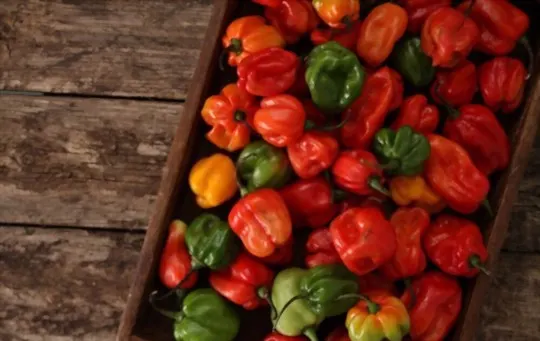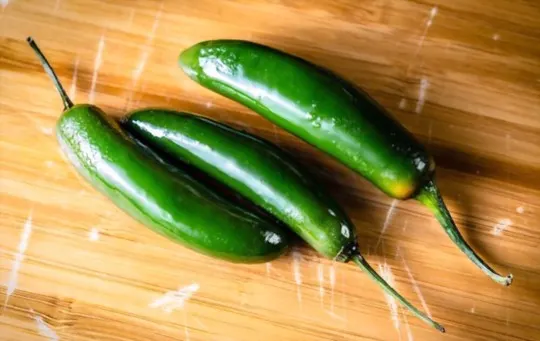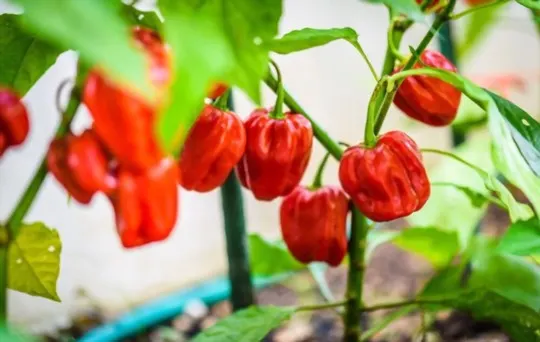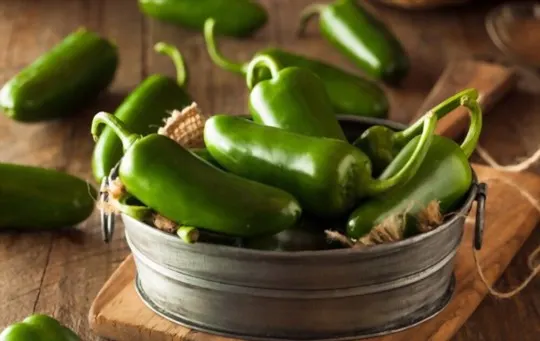We’ve all been there, right?
You’re in the middle of cooking, you reach for that spicy kick of a habanero pepper, and bam – the kitchen’s bare.
Now what? No need to scratch your head or make a last-minute grocery run.
We’ve got you covered with substitutes that pack a punch and keep your dishes on fire.
Ever thought a jalapeño could save the day?
Or that a sprinkle of cayenne pepper could be your next best friend?
We’re here to spill the beans on the five best swaps for habanero peppers.
Trust us, these alternatives will not just save your dish; they’ll elevate it.
What is Habanero Pepper?

Habanero peppers are chili pepper that can grow up to 2 inches in length.
They are native to the Amazonian regions of South America, where they have been cultivated for over six thousand years.
This gives them the claim as the oldest spice known to man today.
Habanero peppers belong to the genus “Capsicum” and derive their name from the Spanish word for “from Havana” about where they were exported from originally.
Their heat index measures around 150,000 Scoville units which is notably hotter than a jalapeno pepper (around 2500 to 8000).
The degree of spiciness depends on how many capsaicinoids are contained within each habanero pepper.
The habanero chili is typically green in color.
Still, it can also be orange, red, or yellow depending on its maturity and the ripeness of the fruit, and how it has been cultivated (with significant variations).
You can find habanero peppers that turn orange-red when ripe.
The distinctive, explosive taste of the Habanero is due to its extreme spiciness and high content of citric acid.
The 5 Best Substitutes for Habanero Pepper
Habanero peppers are known for their fiery heat and distinct flavor, but if you’re unable to find them or prefer a milder alternative, there are several substitutes available.
In this guide, we will compare the top 5 substitutes for habanero pepper, discussing their key characteristics and suggesting proper ratios to help you achieve the desired level of spiciness in your recipes.
| Substitute | Key Characteristics | Proper Ratio |
|---|---|---|
| Scotch Bonnet Peppers | Similar heat level and flavor profile to habanero peppers; fruity and vibrant taste | Use an equal amount of Scotch Bonnet Peppers as a substitute for habanero peppers |
| Serrano Peppers | Spicier than jalapeño peppers but milder than habanero peppers; crisp and bright flavor | Use an equal amount of Serrano Peppers as a substitute for habanero peppers |
| Rocotillo Peppers | Mild heat with sweet and slightly smoky flavor; similar appearance to habanero peppers | Use an equal amount of Rocotillo Peppers as a substitute for habanero peppers |
| Jalapeño Peppers | Milder heat compared to habanero peppers; slightly tangy and grassy flavor | Use an equal amount of Jalapeño Peppers as a substitute for habanero peppers |
| Poblano Peppers | Mild heat and rich flavor; earthy and slightly sweet taste | Use an equal amount of Poblano Peppers as a substitute for habanero peppers |
Now let’s dive into each substitute in more detail:
1 – Scotch Bonnet Peppers

The scotch bonnet is another pepper that you should try when needing a similar kick.
The scotch bonnets originate from the Caribbean and measure between 100,000 to 350,000 Scoville units.
They typically resemble habaneros but are shorter and rounder than these peppers.
The skin of this type of pepper is also thicker than the habanero chili.
This pepper is widely used in Caribbean, African, and Asian cuisines.
The scotch bonnet can be added to curries or stews for increased spice and depth of flavor.
It’s crucial to note that this pepper is more challenging to handle as it contains a ton of capsaicin, which means that you should avoid touching your eyes after handling it.
In addition, this pepper is very hot and can cause a burning sensation to those who consume it without proper preparation.
As such, we recommend adding this ingredient gradually as you prepare a dish.
- Key Characteristics: Scotch Bonnet peppers have a similar heat level and flavor profile to habanero peppers. They offer a fruity and vibrant taste, making them an excellent substitute for those seeking a similar experience.
- Proper Ratio: Use an equal amount of Scotch Bonnet Peppers as a substitute for habanero peppers. Adjust the quantity based on your recipe requirements.
2 – Serrano Peppers

The Serrano Pepper is smaller than habanero and scotch bonnet peppers, with a length of 2 inches.
However, it typically packs more heat than the Habanero and the scotch bonnet pepper.
This chili has a varying heat level as it contains between 5,000 to 15,000 Scoville units.
The heat of this chili also depends on the location it is cultivated or its stage in the harvest.
The serrano pepper is green in color, which means that it matures faster than the red Habanero.
It is also hotter than many other peppers commonly used in North American cuisine.
The crunchy taste of this chili balances its heat so you can enjoy the two flavors together.
Serrano peppers are typically consumed raw, but they can also prepare salsas.
This pepper is available throughout the year, but August and September are peak months for its availability in North America.
Like the scotch bonnet, it’s crucial to avoid touching your eyes after handling this chili pepper and take great care when preparing it.
- Key Characteristics: Serrano peppers are spicier than jalapeño peppers but milder than habanero peppers. They have a crisp and bright flavor, which can add a kick to your dishes without overwhelming the taste buds.
- Proper Ratio: Use an equal amount of Serrano Peppers as a substitute for habanero peppers. Adjust the quantity based on your recipe requirements.
3 – Rocotillo Peppers

The rocotillo pepper is a mild chili that measures about 1,500 – 2,500 Scoville units.
It is used both as an ornamental and for its fruit production; it can grow up to 3 feet tall.
The leaves of this plant are typically bright green and smooth on the surface.
However, the stem is covered in long, white hairs that are soft to the touch.
This pepper originates from Mexico and is typically red.
It can be consumed raw, roasted, or dried as it contains less capsaicin than most chili peppers.
This means that you won’t have to worry about its heat and consume large quantities of this pepper.
The rocotillo pepper is sweet and very mild.
It doesn’t have the unique aroma of other peppers, but it does contribute to dishes with its underlying flavor.
As such, you can use this chili for preparing salsas, sauces, marinades, stews, rice dishes, salads, or tortillas.
The skin of this pepper is easy to remove before it’s cooked.
- Key Characteristics: Rocotillo peppers offer a mild heat with a sweet and slightly smoky flavor. They have a similar appearance to habanero peppers, making them visually appealing as a substitute.
- Proper Ratio: Use an equal amount of Rocotillo Peppers as a substitute for habanero peppers. Adjust the quantity based on your recipe requirements.
4 – Jalapeño Peppers

Jalapeño peppers are readily available year-round, so they are the preferred pepper to use in case of emergency.
These peppers are small and vary between 2 inches and 4 inches.
They have a slightly wrinkled surface but can also be smooth with bumps at times.
Jalapeño peppers are typically green in color, but they can also be read fully mature.
They typically measure between 2,500 and 8,000 Scoville units depending on the cultivar or variety it belongs to.
Jalapeño peppers have a much milder flavor than the habanero pepper, yet their heat will depend on the stages of their growth.
Jalapeño peppers are versatile as they can be used in a wide range of dishes.
You can use them for preparing salads, salsas, sauces, stews, or soups without worrying about inflicting too much heat on the end product.
- Key Characteristics: Jalapeño peppers provide a milder heat compared to habanero peppers. They have a slightly tangy and grassy flavor that can add a pleasant kick to your dishes without overpowering other flavors.
- Proper Ratio: Use an equal amount of Jalapeño Peppers as a substitute for habanero peppers. Adjust the quantity based on your recipe requirements.
5 – Poblano Peppers

Poblano peppers are mildly spicy pepper typically between 1,000 and 2,500 Scoville units.
This chili pepper measures about 4 inches in length, and it has a smooth surface that ranges from dark green to almost black depending on the stage of its maturity.
Poblano peppers have been cultivated in the Mexican region of New Mexico for over 6,000 years.
It represents 30% of chili production in this area and is often used in chili powder.
The poblano is excellent when adding heat to dishes, but it has a nutty flavor with earthy undertones.
The skin of this chili pepper is thin, so you can eat it raw or roasted.
This pepper is perfect for making sauces, salsas, and stews.
- Key Characteristics: Poblano peppers have a mild heat and a rich flavor. They offer an earthy and slightly sweet taste, making them a suitable substitute when you desire a gentle spiciness in your dishes.
- Proper Ratio: Use an equal amount of Poblano Peppers as a substitute for habanero peppers. Adjust the quantity based on your recipe requirements.
Conclusion
Habanero peppers are excellent for adding heat to dishes, but it’s difficult to find substitutes with the same unique flavor.
Scotch bonnet and serrano peppers are two great alternatives to habanero pepper as they have similar heat and flavor.
The rocotillo pepper, jalapeno pepper, and poblano pepper are all milder chili peppers but can add heat to dishes.
You can use them in the same way as you would use habanero pepper, such as preparing sauces, marinades, or stews.

The 5 Best Substitutes for Habanero Pepper
Ingredients
- Scotch Bonnet Peppers
- Serrano Peppers
- Rocotillo Peppers
- Jalapeño Peppers
- Poblano Peppers
Instructions
- Pick your favorite substitute from the list above.
- Follow cooking directions for your selected substitute with the proper ratio of ingredients.

Andrew Gray is a seasoned food writer and blogger with a wealth of experience in the restaurant and catering industries. With a passion for all things delicious, Andrew has honed his culinary expertise through his work as a personal chef and caterer.
His love for food led him to venture into food writing, where he has contributed to various online publications, sharing his knowledge and insights on the culinary world. As the proud owner of AmericasRestaurant.com, Andrew covers a wide range of topics, including recipes, restaurant reviews, product recommendations, and culinary tips.
Through his website, he aims to inspire and educate fellow food enthusiasts, offering a comprehensive resource for all things food-related.

Leave a comment